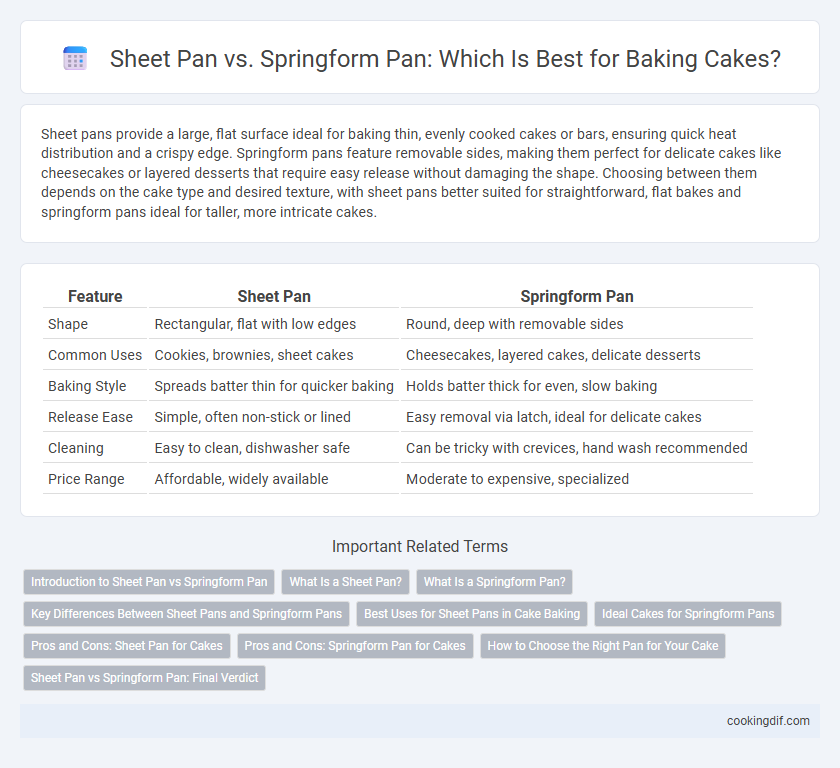Sheet pans provide a large, flat surface ideal for baking thin, evenly cooked cakes or bars, ensuring quick heat distribution and a crispy edge. Springform pans feature removable sides, making them perfect for delicate cakes like cheesecakes or layered desserts that require easy release without damaging the shape. Choosing between them depends on the cake type and desired texture, with sheet pans better suited for straightforward, flat bakes and springform pans ideal for taller, more intricate cakes.
Table of Comparison
| Feature | Sheet Pan | Springform Pan |
|---|---|---|
| Shape | Rectangular, flat with low edges | Round, deep with removable sides |
| Common Uses | Cookies, brownies, sheet cakes | Cheesecakes, layered cakes, delicate desserts |
| Baking Style | Spreads batter thin for quicker baking | Holds batter thick for even, slow baking |
| Release Ease | Simple, often non-stick or lined | Easy removal via latch, ideal for delicate cakes |
| Cleaning | Easy to clean, dishwasher safe | Can be tricky with crevices, hand wash recommended |
| Price Range | Affordable, widely available | Moderate to expensive, specialized |
Introduction to Sheet Pan vs Springform Pan
Sheet pans provide a large, flat surface ideal for baking cookies, bars, and thin cakes with even heat distribution and crisp edges. Springform pans feature removable sides and a secure latch, perfect for delicate cheesecakes, tortes, and layered cakes requiring easy release without damage. Choosing between these pans depends on the cake's texture, structure, and presentation needs.
What Is a Sheet Pan?
A sheet pan is a flat, rectangular metal baking tray with low edges, commonly used for baking cookies, roasting vegetables, and sheet cakes. Its design allows for even heat distribution and easy access to the food, making it ideal for recipes that require a thin, uniform layer. Unlike a springform pan, a sheet pan does not have removable sides, which makes it better suited for simpler baking tasks rather than delicate, layered cakes.
What Is a Springform Pan?
A springform pan features removable sides secured by a latch, allowing easy release of delicate cakes like cheesecakes or tortes without inverting the pan. Unlike a sheet pan, which is flat and ideal for brownies or bars, the springform pan's deep, round shape supports layered cakes and recipes that require gentle handling. This design minimizes damage during removal, maintaining the cake's structure and presentation.
Key Differences Between Sheet Pans and Springform Pans
Sheet pans are flat, rectangular baking trays ideal for cookies, sheet cakes, and roasting, offering even heat distribution and a large surface area for spreading batter thinly. Springform pans consist of removable sides and a base that clamp together, perfect for delicate cheesecakes or layered cakes that require easy release without inverting. The key difference lies in their shape and function: sheet pans provide a flat, open surface while springform pans allow for vertical baking with the ability to remove the cake from the pan without damaging its structure.
Best Uses for Sheet Pans in Cake Baking
Sheet pans excel in baking large, thin cakes like sheet cakes and bars due to their even heat distribution and large surface area, allowing for quick, uniform baking and easy slicing. They are ideal for layered cakes that require multiple thinner cake layers to be baked separately, as well as for roasting nuts or drying fruits to incorporate into cake recipes. Their versatility also extends to making cake bases for desserts like tiramisu or layered trifles, where a flat, firm foundation is essential.
Ideal Cakes for Springform Pans
Springform pans are ideal for delicate cheesecakes, mousse cakes, and layered tortes that require gentle removal without damaging the sides. Their removable sides and secure latch make it easy to release soft or fragile cakes without inverting or cracking. Unlike sheet pans, springform pans provide even baking and maintain structural integrity for rich, dense desserts requiring precise presentation.
Pros and Cons: Sheet Pan for Cakes
Sheet pans offer even heat distribution, producing uniformly baked cakes with crisp edges and a flat surface ideal for layered or sheet cakes. Their large, shallow surface allows for quick baking, but cakes may dry out faster compared to other pans. Cleaning and storage are simpler due to the pan's flat design, though it lacks the depth and shape variety of springform pans.
Pros and Cons: Springform Pan for Cakes
Springform pans offer exceptional ease in removing delicate cakes, especially cheesecakes and mousse cakes, due to their removable sides that prevent damage during extraction. Their design allows for uniform baking and versatile use, but they may experience slight leakage with thin batters if not properly sealed. Compared to sheet pans, springform pans provide a more precise shape and presentation, although cleaning can be more complex due to the pan's assembly.
How to Choose the Right Pan for Your Cake
Choose a sheet pan for cakes that require even heat distribution and a flat surface, ideal for sheet cakes, brownies, or layered desserts. Opt for a springform pan when baking delicate or layered cakes, like cheesecakes or tortes, where easy removal without inverting the cake is essential. Consider the cake's texture and presentation needs, as a springform pan offers high sides for taller cakes, while sheet pans produce thinner, wider cakes perfect for slicing.
Sheet Pan vs Springform Pan: Final Verdict
Sheet pans provide even heat distribution and a flat surface ideal for baking thin cakes or bars with crisp edges, while springform pans offer deep sides perfect for delicate, round cakes requiring gentle removal without damage. The choice depends on the cake type and texture desired; sheet pans excel in quick-cooking recipes, whereas springform pans are preferred for cheesecakes or layered desserts needing structural support. For versatile home baking, investing in both pans ensures optimal results across various cake recipes.
Sheet Pan vs Springform Pan for Baking Infographic

 cookingdif.com
cookingdif.com